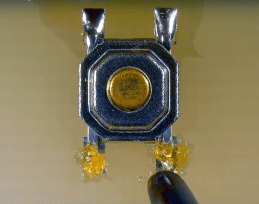Soldering SMDs: occupational therapy!
June 27, 2018
on
on

Nothing like a mechanical component
to dispel your fears.
It’s not just your vision that’s going, but also your curiosity
The video presented here demonstrates that the manual soldering of surface mount components, the dreaded SMDs, is just a technique, within reach of anyone’s abilities. As long as you have the right tools: a fine soldering iron but one powerful enough to keep the heating curve as linear as possible, a microscope (here an Andonstar ADSM201), good lighting and finally solder and solder paste or flux.Andonstar ADSM201 Microscope: the friend of SMD
The devices soldered during this video correspond to current small footprint transistors in SOT case or slightly larger TO cases such as MOSFETs or regulators. These are the types of component you would need to replace during faultfinding.To convince you further, this demo video also includes soldering of several other components: resistor networks, micro pushbuttons, etc.
As rightly pointed out by several commentators, this video is somewhat therapeutic! If, having seen it, you don’t at least want to try it, sadly you’re a lost cause, it seems.
But everything’s not that easy. Experienced SMD workers use less solder, less solder paste (flux) a more powerful (but not necessarily hotter) iron, and they avoid comebacks from dry joints.
Read full article
Hide full article


Discussion (4 comments)